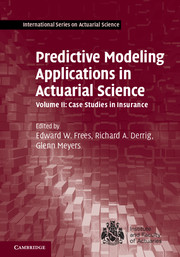Book contents
- Frontmatter
- Contents
- Contributors
- Preface
- Acknowledgments
- 1 Pure Premium Modeling Using Generalized Linear Models
- 2 Applying Generalized Linear Models to Insurance Data: Frequency/Severity versus Pure Premium Modeling
- 3 Generalized Linear Models as Predictive Claim Models
- 4 Frameworks for General Insurance Ratemaking: Beyond the Generalized Linear Model
- 5 Using Multilevel Modeling for Group Health Insurance Ratemaking: A Case Study from the Egyptian Market
- 6 Clustering in General Insurance Pricing
- 7 Application of Two Unsupervised Learning Techniques to Questionable Claims: PRIDIT and Random Forest
- 8 The Predictive Distribution of Loss Reserve Estimates over a Finite Time Horizon
- 9 Finite Mixture Model and Workers’ Compensation Large-Loss Regression Mixture Model and Workers’ Compensation Large-Loss Regression Analysis
- 10 A Framework for Managing Claim Escalation Using Predictive Modeling
- 11 Predictive Modeling for Usage-Based Auto Insurance
- Index
- References
6 - Clustering in General Insurance Pricing
Published online by Cambridge University Press: 05 August 2016
- Frontmatter
- Contents
- Contributors
- Preface
- Acknowledgments
- 1 Pure Premium Modeling Using Generalized Linear Models
- 2 Applying Generalized Linear Models to Insurance Data: Frequency/Severity versus Pure Premium Modeling
- 3 Generalized Linear Models as Predictive Claim Models
- 4 Frameworks for General Insurance Ratemaking: Beyond the Generalized Linear Model
- 5 Using Multilevel Modeling for Group Health Insurance Ratemaking: A Case Study from the Egyptian Market
- 6 Clustering in General Insurance Pricing
- 7 Application of Two Unsupervised Learning Techniques to Questionable Claims: PRIDIT and Random Forest
- 8 The Predictive Distribution of Loss Reserve Estimates over a Finite Time Horizon
- 9 Finite Mixture Model and Workers’ Compensation Large-Loss Regression Mixture Model and Workers’ Compensation Large-Loss Regression Analysis
- 10 A Framework for Managing Claim Escalation Using Predictive Modeling
- 11 Predictive Modeling for Usage-Based Auto Insurance
- Index
- References
Summary
Introduction
Clustering is the unsupervised classification of patterns into groups (Jain et al., 1999). It is widely studied and applied in many areas including computer science, biology, social science and statistics. A significant number of clustering methods have been proposed in Berkhin (2006), Filippone et al. (2008), Francis (2014), Han et al. (2001), Jain et al. (1999), Luxburg (2007), and Xu and Wunsch (2005). In the context of actuarial science, Guo (2003), Pelessoni and Picech (1998), and Sanche and Lonergan (2006) studied some possible applications of clustering methods in insurance. As to the territory ratemaking, Christopherson and Werland (1996) considered the use of geographical information systems. Athorough analysis of the application of clustering methods in insurance ratemaking is not known to the author.
The purpose of this chapter is twofold. The first part of the chapter will introduce the typical idea of clustering and state-of-the-art clustering methods with their application in insurance data. To facilitate the discussion, an insurance dataset is introduced before the discussion of clustering methods. Due to the large number of methods, it is not intended to give a detailed review of every clustering methods in the literature. Rather, the focus is on the key ideas of each methods, and more importantly their advantages and disadvantages when applied in insurance ratemaking.
In the second part, a clustering method called the exposure-adjusted hybrid (EAH) clustering method is proposed. The purpose of this section is not to advocate one certain clustering method but to illustrate the general approach that could be taken in territory clustering. Because clustering is subjective, it is well recognized that most details should be modified to accommodate the feature of the dataset and the purpose of the clustering.
The remainder of the chapter proceeds as follows. Section 6.2 introduces clustering and its application in insurance ratemaking. Section 6.3 introduces a typical insurance dataset that requires clustering analysis on geographic information. Section 6.4 reviews clustering methods and their applicability in insurance ratemaking. Section 6.5 proposes the EAH clustering method and illustrates this method step by step using U.K. motor insurance data with the results presented in Section 6.8. Section 6.7 discusses some other considerations, and conclusions are drawn in Section 6.8. Some useful references are listed in Section 6.9.
- Type
- Chapter
- Information
- Predictive Modeling Applications in Actuarial Science , pp. 159 - 179Publisher: Cambridge University PressPrint publication year: 2016
References
- 3
- Cited by



